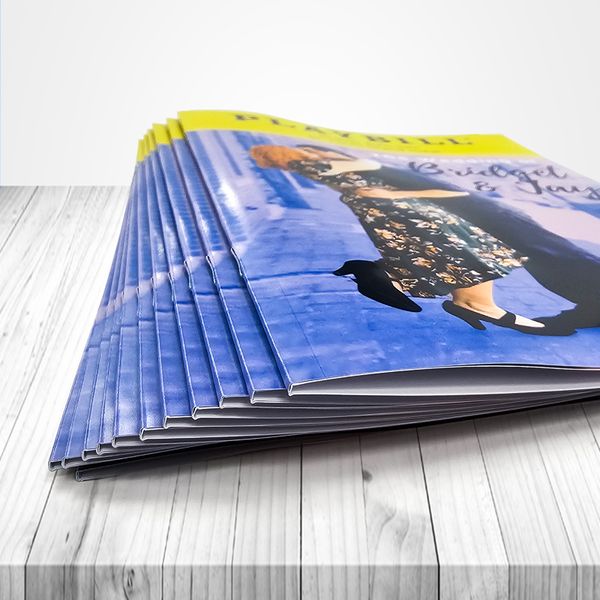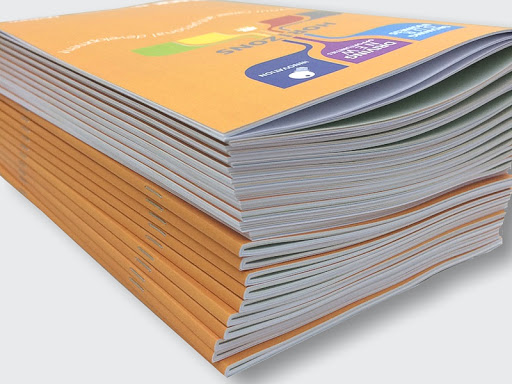Why Businesses in Houston Are Investing in Premium Booklet Printing
Why Businesses in Houston Are Investing in Premium Booklet Printing
Blog Article
The Essential Overview to Understanding Pamphlet Printing Options and Techniques
The procedure of booklet printing involves several considerations that can greatly affect the end product. From choosing the proper format and size to understanding the subtleties of binding methods, each choice plays a vital duty. In addition, variables such as paper stock and printing techniques further influence the performance of the pamphlet. As one navigates these choices, it becomes essential to understand exactly how they adjoin and what that suggests for the total outcome.
Understanding Pamphlet Layouts and Sizes
When considering booklet printing, comprehending the different layouts and dimensions readily available is crucial for attaining the preferred presentation. Pamphlets can be produced in numerous styles, including saddle-stitched, spiral-bound, and perfect-bound, each offering distinctive advantages. Usual dimensions range from conventional letter (8.5 x 11 inches) to smaller options like A5 (5.8 x 8.3 inches), enabling for versatility based on content and target audience.Selecting the suitable dimension can influence both the format and reader engagement. Larger dimensions might suit aesthetically driven content, while smaller sized layouts may be extra mobile and user-friendly. In addition, the variety of pages influences the choice of binding method, as thicker brochures might call for tougher bindings. Eventually, recognizing these aspects enables a much more tailored technique, making certain that the last product aligns with the desired message and aesthetic, improving the total performance of the interaction.
Picking the Right Paper Stock

Binding Methods: Considerations and alternatives
When it comes to binding methods for brochures, a number of options are offered, each with unique advantages. Saddle stitch binding provides a cost-effective service for thinner booklets, while best binding strategies give an even more polished seek thicker magazines. Wire-O binding stands out for its resilience and simplicity of usage, making it suitable for records that require flexibility.
Saddle Stitch Binding
Saddle stitch binding provides a economical and useful remedy for assembling brochures, making it a prominent choice among organizations and publishers. This binding technique entails folding sheets of paper in fifty percent and stapling them along the fold line, developing a cool and orderly appearance. Usually ideal for pamphlets with a reduced web page count, saddle sewing is suitable for publications, brochures, and training materials. The simplicity of this strategy enables for fast manufacturing and is typically favored for advertising things or brief runs. However, it is vital to keep in mind that saddle stitch binding may not be ideal for thicker booklets, as the spine might not stand up under raised weight. Generally, it continues to be a reliable choice for several printing jobs.
Perfect Binding Strategies
Perfect binding is a commonly used method that gives a polished and specialist finish to brochures and publications. This technique entails gluing the web pages together at the spinal column using a strong adhesive, permitting a clean side and the capability to hold a larger variety of web pages contrasted to saddle stitching. Perfect binding is particularly suitable for thicker booklets, such as directories and annual reports, where a tough, level spinal column is wanted. Furthermore, it uses the choice for a printed cover that can be made to improve aesthetic appeal. Nevertheless, considerations such as web page count, paper weight, and the meant usage of the pamphlet should be thought about, as they can impact longevity and overall high quality.
Wire-O Binding Choices
Wire-O binding, known for its toughness and flexibility, offers an exceptional choice for booklets that call for simple page turning and a professional appearance. This binding approach utilizes a collection of steel loops that hold pages securely, allowing them to lie level when open. It is specifically suitable for handbooks, presentations, and directories due to its durable nature. Wire-O binding is offered in different colors and sizes, suiting various page counts and densities. Furthermore, it permits the incorporation of covers and tabs, enhancing the pamphlet's general aesthetic. Factors to consider for Wire-O binding consist of the selection of cable color, the dimension of the loops, and the extent of modification preferred, all of which can profoundly affect the final item's look and functionality.
Digital vs. Offset Printing: Which Is Best for You?
When picking a printing technique for booklets, understanding the distinctions between electronic and balance out printing is important. Digital printing utilizes modern-day innovation to produce high-grade prints swiftly and affordably, making it excellent for brief runs or jobs requiring fast turnaround times. It permits customization, giving the capability to publish on-demand with very little waste.In comparison, offset printing is a typical technique that excels in generating huge amounts with consistent top quality. It involves transferring ink from a plate to a rubber blanket, then to the paper, which causes precise details and vibrant shades. Nonetheless, counter printing commonly calls for longer setup times and is a lot more cost-effective for larger volumes.Ultimately, the option in between digital and counter printing depends on project demands, spending plan, and wanted quantity. For little, time-sensitive jobs, electronic may be the very best choice, while balanced out may be more effective for bigger, high-grade manufacturings.

Creating Your Pamphlet: Tips and Finest Practices
When designing a brochure, cautious interest click reference to layout, font option, and shade use can significantly improve its effectiveness. A well-structured format overviews the visitor's eye, while appropriate fonts ensure readability and communicate the desired tone. Additionally, reliable usage of color can stimulate feelings and emphasize vital info, making the overall layout a lot more impactful.
Choosing the Right Format
Just how can one successfully select the right design for a booklet? It is vital to examine the brochure's purpose and target audience. A clean, organized layout improves readability and engagement. Using a grid system can aid in straightening aspects consistently, producing a professional appearance. Additionally, integrating visual pecking order via varying dimensions and placements of images and text can lead the reader's eye and stress key information. It is additionally important to leave enough white space, which avoids congestion and allows for far better focus. Ultimately, testing different designs via mock-ups can supply insight into exactly how the layout performs in real-world situations, making certain that the final product satisfies both visual and functional needs.
Choosing Proper Typefaces
An appropriate font can significantly improve the general style of a brochure, enhancing the design and enhancing the web content's message. The option of typefaces must take into consideration readability, especially for body text, as it guarantees the information comes to all readers. Sans-serif fonts are frequently liked for electronic formats, while serif font styles can offer a conventional feeling in printed products. It's advisable to limit font selections to two or three to maintain visual comprehensibility. In addition, font style size plays an important duty; headings ought to be unique yet not frustrating, while body text ought to be comfortable for analysis. When choosing fonts, positioning with the brochure's theme and target market is necessary for efficient communication and site visual allure.
Effective Use of Color
Color works as an effective tool in pamphlet style, directing and forming understandings reader feelings. It can stimulate feelings of exhilaration, calmness, or depend on, depending on the colors picked. Designers must think about color theory concepts, making certain that the chosen combination lines up with the pamphlet's message and target audience. For example, making use of warm colors like red and orange can produce seriousness, while cooler tones like eco-friendly and blue foster tranquility.Additionally, contrast plays a crucial duty; complementary colors can enhance readability and visual appeal. Uniformity in color use throughout web pages additionally reinforces brand name identification and communication. Inevitably, reliable shade execution not just catches interest however also reinforces the booklet's purpose, making it a necessary aspect of successful style.
Ending Up Touches: Coatings and Special Impacts
While lots of consider the material and design of a pamphlet the most vital components, the completing touches, such as finishings and special effects, play an important role in enhancing its total charm. Coatings can offer protection and resilience, guaranteeing that the booklet holds up against deterioration. Matte coatings supply an innovative, non-reflective surface area, while glossy coverings can make shades show up more vivid and distinctive. Special results, like embossing or foil marking, include a tactile measurement that can produce a memorable impact. These methods can highlight specific locations, accentuating vital info or creating visual passion. Furthermore, UV covering can supply a high-shine coating that elevates the general look.Together, these ending up touches not just enhance the brochure's visual but additionally communicate professionalism and focus to information, ultimately leaving a lasting influence on the viewers.
Expense Considerations for Pamphlet Printing
Comprehending the read this article different cost factors to consider for brochure printing is necessary for companies and businesses aiming to maximize their budgets. Secret factors influencing expenses consist of the selection of paper, binding, and ink techniques. Better materials, such as superior paper or specialized inks, commonly increase the overall expense. In addition, the size and page count of the brochure play a considerable duty; bigger pamphlets require more resources and time to produce.Another essential factor to consider is the printing method, whether electronic or balanced out, as each has its very own rates framework and viability for various amounts. Businesses ought to likewise consider style expenses, which can vary based on complexity and making use of expert services. Eventually, delivery and handling charges can contribute to the overall, particularly for big orders. By reviewing these components, organizations can make educated decisions that straighten with their monetary abilities while attaining the desired quality in their printed materials.
Regularly Asked Questions
What Are the Ecological Influences of Brochure Printing?
The ecological impacts of booklet printing consist of logging from paper manufacturing, carbon exhausts from transport, and waste generation from disposed of materials - Booklet Printing. Sustainable techniques, such as using recycled paper and environmentally friendly inks, can mitigate these results
How Can I Guarantee Color Precision in My Brochure?
To guarantee shade precision in a brochure, one ought to utilize adjusted screens, use expert shade accounts, conduct test prints, and select top quality printing services that use shade matching and proofing choices for ideal results.
What Is the Regular Turnaround Time for Pamphlet Printing?
The typical turnaround time for booklet printing differs relying on the complexity and quantity - Booklet Printing. Normally, it ranges from a few days to 2 weeks, influenced by variables such as printing techniques and completing requirements
Exist Minimum Order Quantities for Brochure Printing?

Can I Print Brochures in Multiple Languages?
Publishing pamphlets in multiple languages is possible. Lots of printing services provide alternatives for multilingual or bilingual layouts, enabling efficient interaction. Cautious preparation warranties that design components suit numerous languages without endangering readability or visual appeals. Additionally, elements such as paper supply and printing methods further affect the effectiveness of the pamphlet. When thinking about booklet printing, understanding the various styles and dimensions offered is important for accomplishing the desired presentation. When picking a printing method for booklets, comprehending the distinctions between digital and counter printing is crucial. Additionally, the size and web page matter of the booklet play a substantial duty; bigger pamphlets call for more sources and time to produce.Another important factor to consider is the printing method, whether electronic or balanced out, as each has its very own prices framework and suitability for various quantities. The ecological effects of booklet printing include deforestation from paper production, carbon exhausts from transportation, and waste generation from disposed of products.
Report this page